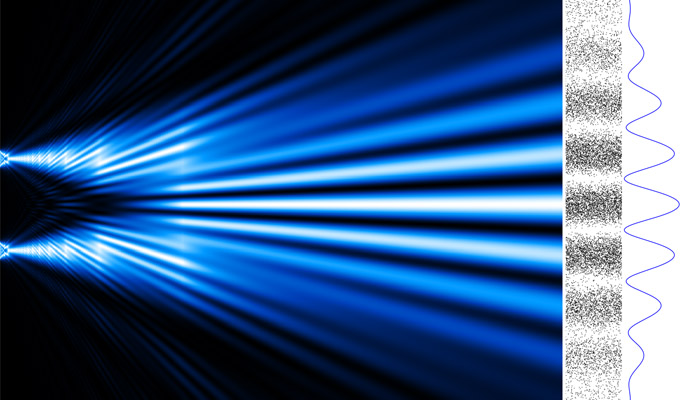Are you a journalist? Please sign up here for our press releases
Subscribe to our monthly newsletter:

One could start this story by thinking about a race: A group of runners takes off at the exact same instant, at the sound of the starter pistol. If each runs at an individual, steady pace, after a while the race track appears to have runners scattered randomly along its length. Now imagine the pistol cracking a second time, signaling to the runners to reverse direction and run backward at exactly the same pace that propelled them forward. Intuitively, one would think that they should all arrive back at the starting block at the exact same instant. This phenomenon is known as an echo. If we now imagine those runners as particles in a quantum system – say, photons or electrons – some of them may not make it back to the starting line. The number of those who fail to report back provides information about interactions that prevented the runners (or the particles) from returning to their starting point. Erwin Hahn identified the first quantum echo – in spins – in 1950, and such echoes have since been discovered in various other quantum systems.
Alternatively, one could go back even earlier, to 1801, when the English physicist Thomas Young conducted an experiment that would come to change the face of physics. In this experiment, universally known as the “double-slit” experiment, Young shone a narrow beam of light on a plate with two thin slits cut into it. On a screen placed behind the plate, he noted an interference pattern. This settled a long-standing argument in physics: It showed conclusively that light behaves as waves. Eventually physicists came to understand that light consists of wave-like particles – photons – that exist “everywhere at once” rather than as single points.

We can now fast-forward to 1965, when Nobel Laureate Richard Feynman asked what was then a hypothetical question: What would happen if the double-slit experiment were conducted with a single photon or electron? Would it pass, wave-like, through both slits simultaneously and interfere with itself? Feynman believed the answer would be yes, but that experimentalists would not be able to conduct such experiments any time soon with single quantum particles. He was too pessimistic about the second part of his prediction: Thirty years ago, Japanese scientists succeeded in performing the double-slit experiment with single electrons, proving that each of them, indeed, passes through both slits as a wave.
Now, some forty-five years after Feynman’s prediction, Prof. Ilya Averbukh, Prof. Yehiam Prior and research student Ilia Tutunnikov of the Chemical and Biological Physics Department at the Weizmann Institute of Science, together with researchers Prof. Jian Wu’s group at East China Normal University (ECNU) in Shanghai, used advanced methods of measuring quantum phenomena to combine the two ideas – that is, to look for an echo in a single molecule having wave properties.

A molecule can vibrate like a tuning fork if it is struck with very short laser pulses. Like a tuning fork, it will give a single “tone,” or frequency, which is determined by the structural properties of the molecule itself. A tuning fork can vibrate louder or softer, and the intensity of the sound can be adjusted continuously by varying the strength of the excitation. However, for a molecule in the quantum realm, a different set of rules applies. Only certain excitation energies are “permitted,” independent of the strength of the laser pulses used. The laser gives the molecules a sort of a “kick,” and in turn, the molecule will be found in one of the permitted states, or possibly in several of them simultaneously. Existing in several states at once is one of the more fantastic properties of quantum mechanics, and it is at the basis of today’s efforts to develop quantum computing.
So a molecule, then, can exist in a group of excited states, forming so-called “wave packets,” which brings the story back to the runners. Each of these quantum states develops at a different pace, and over time, this system appears to be random. Building on this knowledge, the Institute scientists added the second “shot” – an additional laser pulse – re-phasing all of the quantum states back, thus creating an echo.
In a paper recently published in Nature Physics, the Weizmann and ECNU researchers reported that they had managed to measure the echo of these quantum states in a single molecule – proving the existence of the echo just as their theory had predicted. Carrying out echo measurements on single molecules makes these new experiments unlike any that have come before. Going back to the double-slit experiments, in which the interference of a single particle could be seen spatially on a screen, here the researchers did something similar when they measured the wave packet interference of a single particle, but they revealed it in time rather than in space.
The researchers hope these measurements can be expanded from the current two-atom molecules (of argon) to larger and more interesting structures; this may, in the future, give scientists a way to study processes that take place within a single, isolated, complex molecule.
Prof. Ilya Averbukh's research is supported by the Harold Perlman Family. Prof. Averbukh is the incumbent of the Patricia Elman Bildner Professorial Chair of Solid State Chemistry.
Prof. Yehiam Prior's research is supported by the Centre National de la Recherche Scientifique.